Warships in Evangelion: Difference between revisions
UrsusArctos (talk | contribs) |
(→USS Langley(CV-1): very curious. it seems like a weak reason to not show Asuka dying or tanging, but I've never seen any other really plausible explanation for showing everyone ''but'' Asuka) |
||
| Line 140: | Line 140: | ||
(Namesake of [[Asuka]] and her father Langley) | (Namesake of [[Asuka]] and her father Langley) | ||
USS Langley was the first aircraft carrier of the United States Navy, being converted from the collier USS Jupiter, the Navy's first ship to have turboelectric propulsion (Steam-powered generators powering electric motors that turn the propellers). Named after aviation pioneer Samuel Pierpont Langley, she was later converted into a seaplane tender. On February 27, 1942, land based Japanese bombers scored five bomb hits on her. Abandoned after fires and flooding, she was scuttled by her escorts. | USS Langley was the first aircraft carrier of the United States Navy, being converted from the collier USS Jupiter, the Navy's first ship to have turboelectric propulsion (Steam-powered generators powering electric motors that turn the propellers). Named after aviation pioneer Samuel Pierpont Langley, she was later converted into a seaplane tender. On February 27, 1942, land based Japanese bombers scored five bomb hits on her. Abandoned after fires and flooding, she was scuttled by her escorts. [http://eva.onegeek.org/pipermail/oldeva/2001-April/039649.html James Lee] says "No one actually saw the Langley sink" (perhaps connected with how Asuka's death or turning into LCL is not depicted at all in ''End of Evangelion''). | ||
==DKM Graf Zeppelin== | ==DKM Graf Zeppelin== | ||
Revision as of 21:38, 9 September 2011

|
"When Aoba called B Wing's construction sloppy he hadn't seen anything like THIS!" |
This is the list of World War Two vessels that the characters in the show have been named after, giving the bare details of their history.
Warship types
The "historical warships" of Evangelion belong to the World War Two era. Some types of ship from that era have gone altogether- for instance, battleships have been mostly relegated to being museum pieces since the 1950s (Except for a few American ships) and the distinction between "heavy" and "light" cruisers is long gone, with nearly all cruiser types being referred to as plain "cruiser". Aircraft carriers are mostly bigger and better (American supercarriers are colossal, but not all carriers are that big), and destroyers have grown to the size of the old light cruisers, with frigates taking the size category of WW2 destroyers.
Aircraft Carrier
An aircraft carrier can be spotted from miles away- literally. Colossal in size (the biggest ones are over a thousand feet in length), having a flat, wide deck with plenty of aircraft on top and inside, and always accompanied by several escorts, the aircraft carrier is the epitome of naval power. World War Two carriers were smaller than many of their modern equivalents but carried as many or even more aircraft than modern vessels (the average propeller-driven aircraft was positively dinky compared to a modern fighter). Either way, aircraft carriers back during the war performed much the same role as aircraft carriers do today: bring overwhelming power to bear against ships, aircraft and land targets alike.
Battleships
A big-gun battleship is a lot like a samurai sword: magnificent to behold, deadly, powerful and much-feared, but ultimately...pretty useless in modern war, having been tossed out by the aircraft carrier. Even the most powerful battleships ever built, the Yamato and the Musashi, went down to air attack, and those huge guns turned out to be used far more for shore bombardment than for attacking enemy warships. In the end, battleships landed up supporting landing troops and providing extra anti-aircraft protection to carriers. Although the word "battleship" is used by some people in place of "warship", it is technically incorrect (and annoying): a battleship is actually a specific type of warship, with huge guns in revolving turrets and plenty of armor to absorb shells from enemy battleships. Back in their day, any country that owned a battleship belonged to a prestigious, elite group of nations that could throw their weight around (rather like countries owning nuclear weapons today), although they turned out to be vulnerable to mines, submarines and aircraft. There are several preserved battleships in the United States, one of the most famous being the USS Missouri, moored at Pearl Harbor behind the sunken battleship USS Arizona.
Heavy Cruiser and Light Cruiser
Heavy cruisers can be easily confused for battleships, with their big guns and armor plating, but they are always smaller and significantly punier in both armament and armor. These ships started out as "commerce raiders" meant to destroy enemy merchant vessels, as escorts for larger vessels. Many of them were built with powerful engines and a long, narrow hull that gave them the speed to keep pace with fast-moving aircraft carriers, and like battleships, they provided vital fire support to troops on ground.
Light cruisers were less like heavy cruisers, being built with much smaller guns and weaker armor, and were meant mostly to fight smaller surface vessels or lead groups of destroyers into the attack.
Modern cruisers and modern destroyers overlap in their roles, although some Cold War era cruisers are distinguished by being nuclear-powered, which gives them practically unlimited range. The Kirov class missile cruiser is an especially large modern cruiser, and not a new ship type.
Destroyer
Destroyers started out to destroy torpedo-carrying boats that threatened to blow holes in the sides of battleships, hence their name. However, destroyers soon grew in size, speed and destructive power and threatened to blow holes in the sides of battleships themselves. Japanese destroyers from the Second World War were fast, powerful and armed with batteries of torpedoes, which were especially lethal at night, when their wakes wouldn't be seen. Modern destroyers do not use torpedoes in their anti-ship role, instead using them to get rid of submarines.
Modern destroyers use missiles and torpedoes for destroying enemy aircraft, submarines and ships, and in ability and role, largely overlap with modern cruisers.
IJN Aoba(青葉)
(Namesake of Shigeru Aoba)
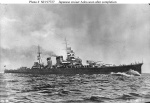
Aoba was the lead vessel in the two-ship Aoba class of heavy cruiser, a little on the older and weaker side when the Second World War broke out, but fairly tough for a ship of its size.
As the flagship of Japanese cruiser division six, Aoba was engaged in the invasion of Guam during the time of the attack on Pearl Harbor, being based out of Truk in the Caroline Islands and providing protection for Japanese troops landing on the Solomon Islands.
After seeing off the Battle of Coral Sea, she participated in the Battle of Savo Island in August 1942, where Japanese warships engaged American vessels in a night gun and torpedo battle. The Japanese Navy had invested heavily in torpedoes and night-fighting techniques to counter the significantly larger U.S. Navy, and they put that investment to good effect. Three American warships and one Australian warship were sunk, and three more damaged. The Battle of Savo Island was one of the most humiliating defeats faced by the United States Navy in a straight battle, and the Aoba was a part of it.
At the Battle of Cape Esperance in October of the same year, Aoba was severely damaged by forty 6-inch and 8-inch shells, but eventually returned to Japan for repairs. Serving mostly in escort duties for the rest of the war, she was damaged again and again by aircraft and submarine attacks, and was finally brought to the Japanese port of Kure as a reserve ship after the damage was deemed beyond repair.
Aoba was converted into an anti-aircraft hulk after yet another bombing, and a final bomb raid in July 1945 put this hardy survivor out of action once and for all. Her wreck was scrapped after the end of the war.
IJN Akagi(赤城)
(Namesake of Ritsuko and Naoko Akagi)
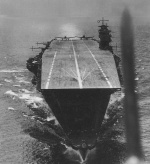
Akagi was one of the most famous of all Japanese warships, and certainly the most famous Japanese aircraft carrier. Akagi was laid down as an Amagi-class battlecruiser in 1920 and converted into an aircraft carrier thanks to the 1922 Washington Naval Treaty, an agreement between America, the United Kingdom, France, Italy and Japan which imposed limitations on warship design and production on all the nations and which proved rather disappointing for Japan, in restricting the total weight of ships that it could build. Akagi's name, which means "Red Castle", comes from a mountain of the same name, Mount Akagi(赤城山,Akagi-Yama ), in the Gunma Prefecture of Japan.[1] Since Akagi had the hull and engines of the original battlecruiser design (with a hangar and flight deck built on top), it was fast and powerful, one of the best of the early carriers.
Akagi sealed her place in history when she served as the flagship of Vice-Admiral Chuichi Nagumo during the December 7, 1941 attack on Pearl Harbor, launching two waves of aircraft at Oahu. She was constantly active in the following six months, and served on other campaigns in the Pacific, such as supporting the invasion of the port of Rabaul in the Bismarck islands in New Guinea. Her aircraft sunk several ships including the world's first aircraft carrier, the British carrier HMS Hermes.
Akagi's final battle was the Battle of Midway, where she would be one of the four Japanese carriers lost, a defeat that would spell the beginning of the end of the Japanese Empire in the Pacific. On June 4, 1942 Akagi was attacked by dive bombers from the aircraft carrier USS Enterprise with one bomb hit damaging the rudder. Another bomb exploding among armed and fueled planes set off a chain of fires and explosions that proved impossible to control, leading to her being abandoned. Severely damaged by fire but still floating, she was scuttled the next day by torpedoes from four destroyers. Akagi was the luckiest of the four carriers lost, suffering the fewest deaths among all crew.
As is often the case among warships, Akagi was not the first ship of the Japanese Navy to bear that name. The first Akagi was (curiously enough, from an Evangelion standpoint) a Maya-class gunboat of the late nineteenth century.
IJN Ayanami(綾波)

(Namesake of Rei Ayanami)
Ayanami was the first of the Type-II Fubuki class destroyers, an improved version of what was the world's first modern destroyer. Ayanami served as a namesake for her particular model (Although her sister Shikinami was the first to be completed and brought into service, Ayanami had been laid down a full six months earlier).
The old Fubuki-class was bigger, faster and more powerful than any other destroyer type in existence during the 1920s, with fully enclosed bridges and armaments (which protected crews from the elements and provided vastly superior working conditions). The Ayanami subclass was distinguished from the preceding vessels by a gun turret that could elevate to 75 degrees instead of just 40 degrees, making her the first destroyer in the world to have a main gun that could be put to anti-aircraft use (the gun was too slow to aim at aircraft in practice, however). Like other vessels of the Fubuki class, Ayanami was heavily armed, with three triple torpedo tube launchers for the deadly 610mm Type 93 "Long Lance" torpedo, a weapon with a higher speed, longer range and heavier punch than any of its foreign counterparts. Ayanami's torpedoes could blow a gaping hole in any ship at twenty kilometers, while U.S. destroyers would have to close to half the distance to use their own torpedoes.
In December 1941, Ayanami, along with her sister ships Uranami and Yugiri, sank the Dutch submarine O-20 and in March 1942, Ayanami provided close cover for the invasion of the Andaman Islands in the Bay of Bengal. In addition, she served as an escort for Admiral Yamamoto's main body during the Battle of Midway, forming Destroyer Division 19 along with her sister ships Isonami, Shikinami and Uranami.
Ayanami's last action was the Second Battle of Guadalcanal on the night of November 14-15, 1942, along with the Uranami and Nagara, sinking or inflicting severe damage on multiple U.S. destroyers before being spotted and shelled by the battleship USS Washington. Suffering critical damage and with forty of her crew killed, the rest evacuated either to Guadalcanal by boat or to the Uranami. She was scuttled by a single torpedo from the Uranami. Her wreck was discovered at the bottom of Ironbottom Sound by marine archaeologist Robert Ballard(of Titanic and Bismarck fame) in late July 1992.
IJN Fuyutsuki(冬月)

(Namesake of Kozo Fuyutsuki)
Fuyutsuki was an Akizuki-class destroyer of the Japanese Navy, her name literally meaning "Winter Moon." For a fairly advanced and potent vessel, her wartime record is pretty sketchy. Fuyutsuki does have one claim to fame: she rescued survivors from the Yamato after the mighty battleship was sunk by American aircraft. On August 20, 1945, Fuyutsuki was crippled by a mine, and surrendered unrepaired and without armament. Three months later she was struck from the Navy List, serving as a breakwater before being scrapped.
IJN Hyuga(日向)

(Namesake of Makoto Hyuga)
Hyuga was built as an Ise-class battleship, a heavily redesigned version of the previous Fuso-class battleship. Both these battleship types were strange-looking ships, with main gun turrets along most of their length. Their armor had to be thinned due to being distributed along such a significant portion of the ship's length, which made them somewhat poorly protected. Completed in 1918, Hyuga was updated extensively between 1926 to 1928 and again between 1934 to 1936.
After the disastrous Battle of Midway where four aircraft carriers were lost, the IJN considered converting all battleships except for the Yamato and Musashi into aircraft carriers, eventually settling on a scheme of converting the oldest and least useful battleships into hybrid battleships/carriers, having the aircraft take off from the battleship-carriers and land on conventional carriers or land bases. In the end, the lack of aircraft and the sheer impracticality of the arrangement made Hyuga and Ise useless in this role. As a consequence, their role in the war was nearly nil, placed in limbo due to being neither full battleships nor proper carriers.
Hyuga was beached in shallow waters during an attack by American aircraft near Kure in July 1945. After the war's end, she was raised and scrapped.
Hyuga was named for the Hyuga province in Kyushu.
IJN Ibuki(伊吹)
(Another namesake of Maya Ibuki)
Ibuki was a ship that was never completed. She was meant to be an improved version of the powerful Mogami-class heavy cruiser, with the weight limitations of the 1922 Washington Naval Treaty removed to make as good a warship design as possible. Her construction was slowed after the Battle of Midway to give way to aircraft carrier production, before she was converted to a full aircraft carrier herself. However, bombing and acute material shortages made construction impossible by March 1945. She was 80 percent complete when she surrendered to occupying forces in September and was scrapped two years later.
IJN Katsuragi(葛城)

(Namesake of Misato Katsuragi)
Katsuragi was an Unryu-class aircraft carrier of the IJN, a variant of the Hiryu/Soryu aircraft carrier design with weaker engines. Finished late in the war, she did not commit to any serious action, serving mostly as a ferry for "Okha" kamikaze rocket aircraft. Surviving the war, she landed up ferrying troops until she was scrapped in 1947.
IJN Kirishima(霧島)
(Non-canonical Mana Kirishima)

Kirishima was a Kongo-class battlecruiser, one of the best warships in the world at the time of her commissioning in 1915, having a superb mix of speed, hitting power and armor protection (Although battlecruisers were poorly armored compared to battleships, the Kongos were well protected for their time).
In 1933-34 she was extensively modernized and converted into a "fast battleship", 4000 tons heavier than before. All ships of the class, once modernized, proved to be immensely useful, even if they were the oldest capital ships of the Imperial Japanese Navy. Kirishima served as an escort for the Carrier Striking Force during the attack on Pearl Harbor and beyond, including during their brief rampage in the Indian Ocean and the disastrous Battle of Midway. She participated in the Battle of the Eastern Solomons and the Battle of Santa Cruz. On November 15, 1942 Kirishima engaged American vessels during the Battle of Guadalcanal, inflicting damage on the battleship South Dakota. However, the battleship Washington, only seven kilometers away, had not been spotted, and it shelled Kirishima with radar-directed gunfire from both her main and secondary batteries. Heavily damaged and on fire(no amount of modernization could up-armor her to true battleship standards), Kirishima was abandoned and her kingston valves were opened to scuttle the ship. Her wreck was discovered in 1992 by Robert Ballard (famous for exploring the wrecks of the Titanic and the battleship Bismarck).
IJN Makinami(巻波)
(Second namesake of Mari Illustrious Makinami)
Makinami was a Yugumo-class destroyer, her name meaning "overflowing waves". Makinami escorted the battleships Kongo and Haruna and heavy cruisers Maya and Myoko in the shelling of Henderson Field during the Guadalcanal campaign, running numerous transport runs to the island. She was sunk by torpedoes and gunfire during the battle of Cape St. George on 24-25 November 1943.
IJN Maya(摩耶)

(First namesake of Maya Ibuki)
Maya was one of the four Takao-class heavy cruisers, named after a mountain (摩耶山 Maya-Yama) near Kobe. This particular class of cruiser was distinguished by a huge, battleship-like bridge structure and heavy gun and torpedo armament, and Maya would have been a formidable combatant in a fight against other cruisers, had such a battle taken place. She was sunk by submarine attack on October 23, 1944, during the Battle of the Palawan Straits.
IJN Musashi(武蔵)
(Non-canonical Musashi Lee Strasberg, Girlfriend of Steel)
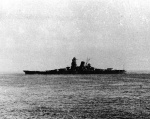
Musashi was the sister ship of the mighty Yamato, one of the two the largest, most heavily armed and armored battleships ever constructed. These monsters had armor two feet thick on their turret fronts, and each of their nine main guns could fire a shell 18 inches in diameter and weighing as much as a family car to a distance of forty kilometers. Unfortunately for the Japanese, their poor choice of engine design had led to these monsters being very fuel-inefficient, and neither of them ventured far.
Serving as Admiral Isoroku Yamamoto's flagship after her commissioning, Musashi was also to return his ashes to Japan (After being killed when the aircraft carrying him was shot down in a special U.S. Army Air Forces operation, a rare 'assassination'). She joined the Yamato for the Battle of Leyte Gulf and on October 24, 1944 she was attacked by American carrier-based aircraft. Struck by 17 bombs and 20 torpedoes (and possibly even more: whatever be the case, this ship took an incredible thrashing), the great battleship keeled over and sank taking over a thousand of her 2399 crew with her, the rest being rescued by the accompanying destroyers.
IJN Soryu(蒼龍 )

Soryu was the first purpose-built heavy aircraft carrier of the Imperial Japanese Navy, built solely as a carrier and based on the experience learnt with the older carriers Akagi (converted from a half-built battlecruiser) and Kaga (converted from a half-built battleship). At the time of her introduction, she was the fastest carrier in the world, with a speed of 34 knots, and capable of matching the Kaga's maximum speed at only forty percent of her full power. Soryu was followed by her modified sister ship Hiryu, which was almost 2000 tons heavier and had a different flight deck and island configuration.
Soryu was one of the six aircraft carriers to take part in the attack on Pearl Harbor, and served in numerous other pacific campaigns in the months to follow. On June 4, 1942, the Soryu was attacked by dive bombers from the USS Yorktown, taking three bomb hits. Two penetrated the upper hangar deck, and the third penetrated down to the lower hangar deck before exploding, setting off a chain reaction among the armed and fueled planes stored inside the hangar decks and waiting to take off. She lost 711 of her 1103 crew, the single highest loss at Midway, because of the fires being in both her hangar decks.
All purpose-built Japanese carriers were named after mythical or sacred flying creatures. In this case, Soryu literally means green(or blue) dragon.
IJN Shikinami(敷波)
(From Asuka's name in Rebuild- Kanji different from character name?)

Shikinami was a Type-II Fubuki class destroyer, the same model as the Ayanami. Although she was completed and commissioned before the Ayanami, she was ordered later, and construction on her began a full six months later, which is why her subclass is named "Ayanami" and not "Shikinami". Like all Fubuki-class vessels, she possessed armament and performance well ahead of other destroyers of her time.
Along with Ayanami, Isonami and Uranami, she was assigned to Destroyer Division 19 of the Japanese 2nd Fleet in 1941, and served as an escort in Admiral Yamamoto's main fleet during the Battle of Midway. She survived the Second Battle of Guadalcanal(In which Ayanami and Kirishima were lost) and allied air attacks during the Battle of the Bismarck Sea. She continued serving in escort duties until she was torpedoed and sunk by the submarine USS Growler (SS-215) on 12 September 1944.
Other Warships
USS Langley(CV-1)

(Namesake of Asuka and her father Langley)
USS Langley was the first aircraft carrier of the United States Navy, being converted from the collier USS Jupiter, the Navy's first ship to have turboelectric propulsion (Steam-powered generators powering electric motors that turn the propellers). Named after aviation pioneer Samuel Pierpont Langley, she was later converted into a seaplane tender. On February 27, 1942, land based Japanese bombers scored five bomb hits on her. Abandoned after fires and flooding, she was scuttled by her escorts. James Lee says "No one actually saw the Langley sink" (perhaps connected with how Asuka's death or turning into LCL is not depicted at all in End of Evangelion).
DKM Graf Zeppelin

(Namesake of Kyoko Zeppelin Soryu)
Graf Zeppelin was an aircraft carrier of the Deutsche Kriegsmarine (DKM) that was canceled when it was 95 percent complete, resources being diverted to U-Boat construction instead. The incomplete carrier fell into the hands of the Soviet Union. On 16 August 1947, it was sunk in a simulation exercise aimed at sinking a carrier, which was deemed necessary considering a possible future war with the United States. The wreck was discovered close to the Polish port of Łeba in July 2006.
HMS Illustrious
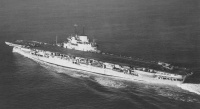
(First namesake of Mari Illustrious Makinami) HMS Illustrious was the fourth ship of her name, an aircraft carrier of the Royal Navy. Nicknamed "Lusty", Illustrious served in the Mediterranean, where she took part in the raid on Taranto, and later suffered extensive damage from aerial attack. After a long period in the Mediterranean and the Indian Ocean, she was shifted to the British Pacific Fleet, covering the landings at Okinawa and taking three strikes from kamikaze aircraft. Seriously damaged in the last strike, she was under repair till the war ended, at which point she was reclassified as a training ship, with her speed restricted to 22 knots by wartime damage. Refitted and modernized in 1948, she served for another six years before being decommissioned and scrapped.
External Links
http://www.combinedfleet.com/kaigun.htm (This site is superb.)
http://www.hazegray.org/navhist/carriers/ (Links to a number of aircraft carriers)
The United Nations Pacific Fleet
This consists of the real-life vessels that Gainax included in Episode 08 as part of the United Nations Pacific Fleet escorting Eva-02 to Japan.
USS Harry S. Truman
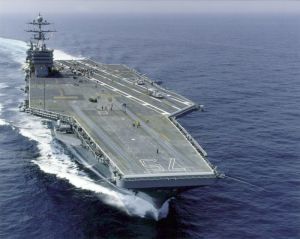
(In Evangelion, it was renamed "Over the Rainbow" and used as Pacific Fleet Flagship. Its reactors provided electrical energy for Eva-02 and the flight deck served as the stage for a short brawl between Eva-02 and Gaghiel.)
USS Harry S. Truman is an American Nimitz-class nuclear powered aircraft carrier, and that makes it one of the most powerful warships afloat, capable of taking ninety to a hundred combat aircraft anywhere in the world. The presence of a Nimitz-class carrier in any part of the world is, in layman's terms, big business. Truman is the eighth carrier, being named after the 33rd President of the United States, Harry S. Truman. Two more Nimitz-class carriers- the USS Ronald Reagan and the USS George H.W. Bush, have been built after the Truman, with additional modifications added along the way.
The Truman was the last carrier built before the year 2000, construction being underway at the time Evangelion aired. When it was officially commissioned (brought into service as a warship) on July 25, 1998, President Bill Clinton was the keynote speaker of the commissioning ceremony. Based in Norfolk, Virginia (As of this writing), her crew has won several awards, and the ship has taken part in numerous exercises and operations. It took part in five weeks of relief efforts in the Gulf Coast following the aftermath of Hurricane Katrina.
http://en.wikipedia.org/wiki/USS_Harry_S_Truman (General information)
http://www.navysite.de/cvn/cvn75.html (Unofficial website)
http://www.truman.navy.mil/ (Official website)
Heavy Missile Cruiser Kirov(Currently Admiral Ushakov)
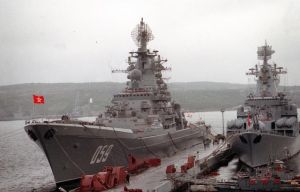
(In-series: Seen only on a display with the battleships Illinois and Kentucky.)
Kirov was the first ship belonging to Russian Navy Project 1144 Orlan(Sea Eagle, the Russians named big ships after birds), classified by the Russians as a "Heavy Missile Cruiser" and known in the west as the Kirov-class battlecruiser (Note: Russians do not put their ships into "classes" named after the first vessel, as in the west). Kirov and her sister ships Frunze, Kalinin and Yuri Andropov (Renamed Admiral Ushakov, Admiral Lazarev, Admiral Nakhimov and Peter the Great respectively after the fall of the USSR) are the four largest and most powerful missile cruisers ever built, designed to attack American aircraft carriers and their escorts with their huge missiles. Classified as "heavy missile cruisers" in Russia and "Battlecruisers" in the west (Real battlecruisers are long gone, the moniker was adopted due to their size and armament), the appearance of these vessels was a factor in the reintroduction of the World War Two era Iowa class battleships in the 1980s.
Powered by two nuclear reactors with auxiliary steam propulsion (a weird arrangement...with nuclear reactors, you'd think they'd have all the power in the world), they carry twenty massive P-700 Granit anti-ship missiles, appropriately called the SS-N-19 "Shipwreck" by NATO. They have a formidable battery of anti-aircraft missiles, and an assortment of anti-submarine and close-in weapons systems, and assorted electronics systems. Weapons and electronics vary from ship to ship, with the last ship, Peter the Great, being the most advanced. At present, the surviving vessels have their condition threatened by poor maintenance and a lack of funding, although the Russian Navy does want to bring them back into their prior operational condition.
http://en.wikipedia.org/wiki/Kirov_class_battlecruiser (General information and links)
http://www.globalsecurity.org/military/world/russia/1144.htm
http://www.fas.org/man/dod-101/sys/ship/row/rus/1144.htm
Iowa class
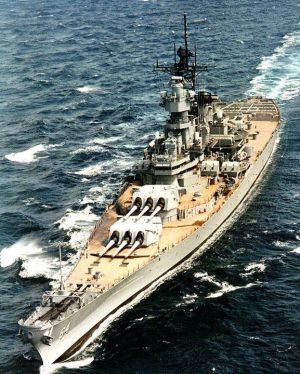
(In-series: Two ships that in real life were canceled while partially complete, Illinois (BB-65) and Kentucky (BB-66), used to destroy Gaghiel. One more Iowa is seen when Eva-02 makes its final landing on the carrier.)
The Iowa-class battleships were the last battleships built by the United States Navy, and the most technologically advanced battleships ever made, more powerful than all but the Japanese Yamato class. Originally planned as a class of six battleships, only four were built, with the other two, Illinois and Kentucky, scrapped while still incomplete, in 1945 and 1947 respectively. (Kentucky was to be a missile battleship if completed)[1].
Serving mostly as antiaircraft screens for Aircraft Carriers and shore bombardment platforms, the Iowas were mothballed after World War II, brought back into action during the Korean War and then mothballed again. In 1968, New Jersey was briefly recommissioned and brought into the Vietnam War. In the 1980s, the class was recommissioned again under Ronald Reagan's 600-ship Navy initiative in the 1980's to fulfill the offshore bombardment role and provide a foil to the Kirov class. They were heavily modernized and fitted out with electronic warfare systems, Phalanx CIWS, Harpoon anti-ship and Tomahawk cruise missiles. Missouri was used in Operation Desert Storm in 1991, the last wartime use of the Iowa-class. Decommissioned for good in the early 1990s, the last two Iowas were removed from the mothball fleet for good in 2006.
http://en.wikipedia.org/wiki/Iowa_class_battleship
Heavy Aviation Cruiser (Aircraft Carrier) Kuznetsov
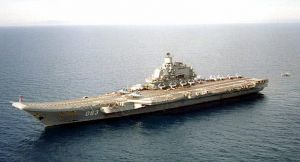
(In series: Kuznetsov seen in a few shots, and appears to have taken damage from Gaghiel.)
Admiral Kuznetsov was built under Russian Navy Project 1143.5, as a larger and far more capable follow-on to the Project 1143, or Kiev-class. Kuznetsov is designated an Aircraft Carrier in the west and a "Heavy Aviation Cruiser" by her builders, combining an offensive air wing of Su-33 fighters and Ka-27 antisubmarine helicopters with formidable point-defense six-barrel guns and a large missile arsenal, including twelve massive P-700 (SS-N-19) antiship missiles. Western carriers of similar size tend to carry far more aircraft and less guns or missiles, making Kuznetsov's Russian designation at least partially appropriate.
Unlike western carriers that use a steam catapult system to launch aircraft, the Kuznetsov allows aircraft to take off from a ski-ramp on the bow of the ship instead. This reduces the stress on the pilot and aircraft when compared to a catapult launch, but it places a limit on the weight of the aircraft during takeoff. The Su-33 can not take off from the ski-ramp with a full load of fuel and weapons, which restricts its range and forces it to use a light loadout of weapons (mostly air-to-air missiles). Despite these limitations, aircraft on the Kuznetsov can take off and land conventionally, unlike the previous Kiev class carriers which could only carry VTOL(Vertical Takeoff and Landing) aircraft.
At present, Kuznetsov is only operational carrier of the Russian Navy and the only one of that particular construction project, although her incomplete sister vessel Varyag landed up being sold to China and looks to be heading for completion as China's first aircraft carrier. Russia has plans to modernize Kuznetsov and equip it with steam catapults like western carriers and replace the old-fashioned steam engines with gas turbines or nuclear reactors.
http://en.wikipedia.org/wiki/Russian_aircraft_carrier_Admiral_Kuznetsov
http://www.globalsecurity.org/military/world/russia/1143_5.htm
http://www.webcom.com/~amraam/rcar.html
Oliver Hazard Perry class FFG
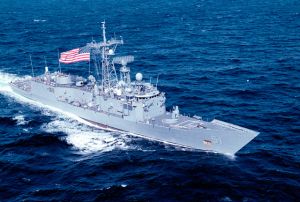
(In-series: Take the brunt of Gaghiel's attack. A number of them are shown burning or exploding.)
The Oliver Hazard Perry class were built in the 1970s and 80s as general-purpose escort vessels to replace a large number of aging World War II era destroyers, and take on a whole number of small roles. Built in two batches (One slightly longer than the other), these vessels are aging and now due for a major refit including a removal of obsolete offensive weaponry.
Nevertheless, the Perry class frigates have proven to be tough vessels for their size. In 1987, the frigate USS Stark was attacked, seemingly by mistake, by Iraqi Exocet anti-ship missiles and sustained severe damage, including the deaths of thirty-seven sailors, but survived. Barely a year later, USS Samuel B. Roberts was damaged by an Iranian mine, and ten severely wounded crewmen had to be taken off the ship.
http://en.wikipedia.org/wiki/Oliver_Hazard_Perry_class_frigate
USS Ramage (Arleigh Burke Class DDG)
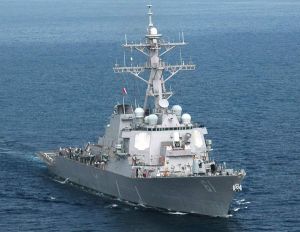
(In-series: Gun turret wrecked by Eva-02 when Asuka went "ship-hopping".)
The USS Ramage is an Arleigh Burke class Destroyer of the United States Navy, commissioned in 1995. It, along with the other Arleigh Burke class vessels, is one of the largest and most powerful destroyers ever made, built entirely of steel(except for an aluminum mast) to reduce the damage done by antiship missile strikes. Rammage and her sisters have an air-filtration system against nuclear, biological and chemical warfare, the first US ships to use one.
http://en.wikipedia.org/wiki/USS_Ramage_%28DDG-61%29
Other Warships in the Show
DDG-099 Farragut
(In-series: Gendo transmits from this vessel, offscreen, at the end of Episode 12. Unlike the other warships listed on this page, it didn't exist at the time the show was made.)
Farragut is an Arleigh Burke-class destroyer of the US Navy, the 49th ship of the Arleigh Burke class. It was laid down on January 9, 2004 and christened on July 23, 2005. http://en.wikipedia.org/wiki/USS_Farragut_%28DDG-99%29
Reference List
- ↑ While cruisers and battlecruisers and ships converted from cruisers or battlecruisers were named after mountains, ships built as aircraft carriers from the start, such as the Soryu, were named after flying creatures.
